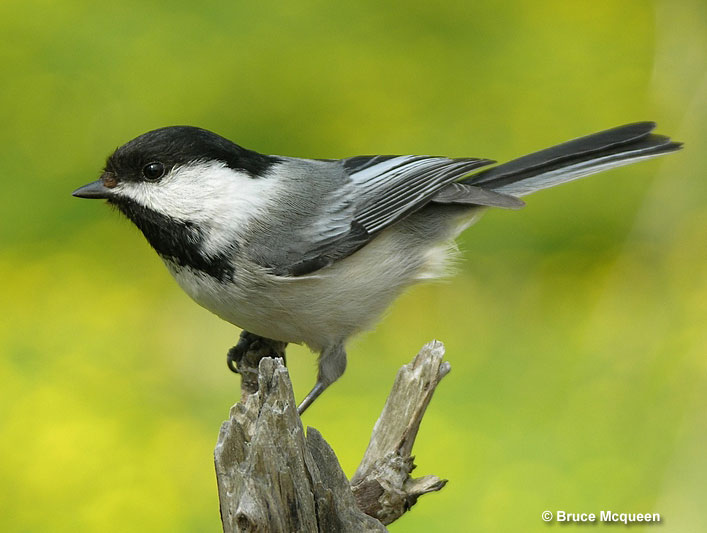Black-capped Chickadees (Poecile atricapillus) are small, non-migratory birds native to North America.
They are known for their distinctive black cap and bib, which contrasts with their white cheeks and greyish wings and back. You can often see them in flocks during the winter months, where they can be heard singing their cheerful chick-a-dee-dee-dee call.
On this page
Adult
These small birds boast a black cap and throat, white cheeks and bellies, a gray back, black-and-white wings and tail, and light tan flanks. They have a short black bill, black eyes, and dark legs. Their head is comparatively large in proportion to their short neck, which makes them look rather round.
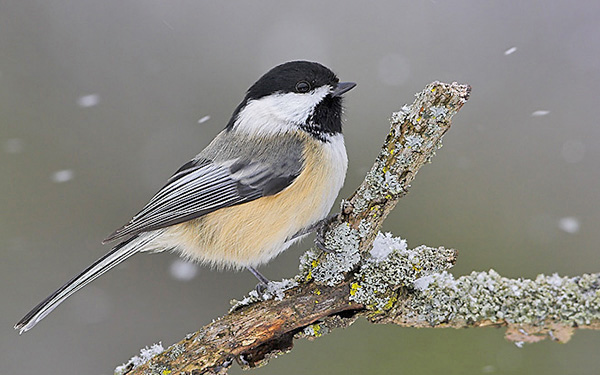
Male and female Black-capped Chickadees look nearly identical. The only difference is that males are slightly longer and larger than females. In the field, it is almost impossible to tell them apart by appearance alone.
They’re a bit smaller than a sparrow, measuring only 4.7-5.9 inches in length and weighing around 0.3-0.5 ounces.
Juvenile
These birds breed only once a year. However, their clutches can be rather large. They may have as little as one and as many as thirteen, but generally, 6-8 eggs in a clutch. Black-capped Chickadee eggs are white and have fine reddish-brown dots, especially towards the egg’s larger end.
The female Black-capped Chickadee incubates the eggs on her own, which takes about 12-13 days. At first, the female remains with the young, and only the male brings food. Later, both parents are responsible for feeding them. The offspring leave the nest after about 12-16 days and reach independence at around 5 weeks of age.
Juvenile Black-capped Chickadees look similar to adults, but their colors are brighter. Their flanks are noticeably more rust-colored.
Habitat
Black-capped Chickadees inhabit various habitats that have trees and woody shrubs. They prefer deciduous and mixed forests that have birches and alders, open woodlands, parks, willow thickets, and cottonwood groves, and may also be seen in suburban areas and backyards.
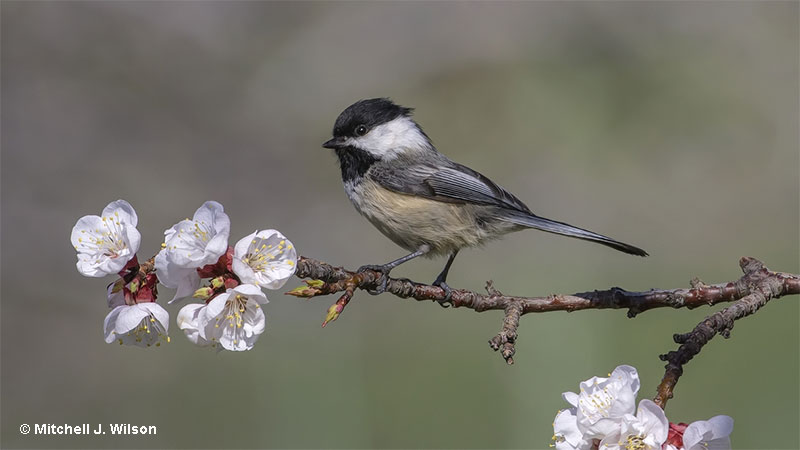
© Mitchell J. Wilson
Black-capped Chickadees nest in both natural and artificial cavities. You can find them in holes in trees, old woodpecker holes, or nesting boxes. In natural cavities, both sexes help to enlarge the interior.
The female builds the nest herself. The base of the cup is made of moss and other coarse materials, whereas the inner part is lined with softer materials, such as animal hair.
Diet
Black-capped chickadees eat both animal and plant matter, but the majority of their diet is made up of animal foods, such as insects and spiders. Their specific diet varies from season to season.
During the breeding season, at least 90% of their diet consists of different invertebrates, including caterpillars, insects, spiders, and snails.
The other part is made up of berries, seeds, and fruits. In the winter, plant matter makes up almost half of their diet. They will also eat fat and bits of meat from animal carcasses.
These lively birds forage by gleaning food from twigs and branches. They hop from one branch to another, sometimes hanging upside down to reach food. You may also see them briefly hovering or flying out to catch insects in mid-air. They’re frequent visitors to bird feeders.
Behavior
Black-capped Chickadees have dominance hierarchies, which is usually based on the age and sex of the bird. The older the bird, the more dominance it has, and males are dominant to females. During the winter, they’re social and form flocks but these disperse at the beginning of the breeding season.
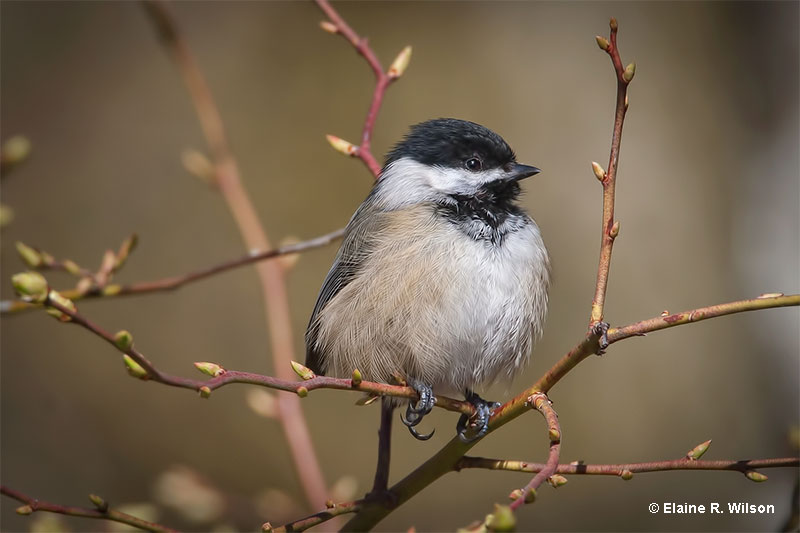
They’ll form monogamous bonds, with dominant individuals mating with other dominant ones, and the pairs are very territorial over their nesting area.
Even though they’re small, Black-capped Chickadees still try and chase away predators. They will call and mob them, and when near the nest, the chickadee will land near the predator and spread their tail and raises and lowers its wings in a display and an attempt to confuse them.
Range (and seasonal changes)
Black-capped Chickadees range throughout most of North America. They cover the upper two-thirds of the United States, with their range extending to southern Canada and Alaska. There are usually no seasonal changes, and they’re mostly year-round residents.
These birds are listed as a species of least concern on the IUCN Red List, with their population increasing.
Wing shape
Black-capped Chickadees have a wingspan of 6.3-8.3 inches. Their wings are short and broad, good for quick acceleration, taking off quickly, and maneuverability at low speeds.
This is perfect for foraging in the trees, flying and maneuvering between branches, and taking off quickly to avoid predators.
Fun Facts
- Black-capped Chickadees have adapted to remembering important and relevant information. They can rewrite their memory to get rid of old and replace it with new information. This includes information about where they’ve hidden food and changes in the social structure of their flocks.
- Black-capped Chickadees work together with each other and other bird species. When one sounds the alarm, other birds react to it even when they don’t have a similar alarm call.
- Black-capped Chickadees may interbreed with other chickadee species, such as the Carolina Chickadee, Mountain Chickadee, or Boreal Chickadee.
- Maine and Massachusetts have the Black-capped Chickadee as the state bird.
- Even during cold winter nights, these birds still sleep alone in their individual cavities. They can lower their body temperature as much as 53 degrees Fahrenheit (or 12 degrees Celsius) to conserve energy.
Call
The most common Black-capped Chickadee song is a 2 or 3-note high-pitched whistle that sounds like hey sweetie or fee-bee. The whistles are very clear and pure without any additional warbling or buzzing.
Black-capped Chickadees have many different types of calls to express alarm, aggressiveness, and other things. They let out a series of high-pitched twitters, dee-dee-dee when they’re alarmed.
When a lower-ranked bird gets too close to a higher-ranked one, then it might be met with a “gargle” call. This is also given between members of a pair.
Similar Species
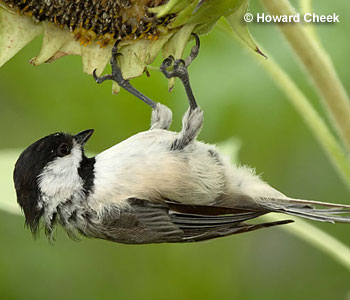
Carolina Chickadee
Black-capped Chickadees and Carolina Chickadees look amazingly similar, but Carolina Chickadees are a bit smaller than Black-capped Chickadees.
The main difference between the two comes in the form of their respective ranges. They do have some overlap, but Carolina Chickadees live mainly in the southeastern side of the United States, while Black-capped Chickadees live through most of North America, ranging as far as Alaska.
Frequently Asked Questions
What is the importance of the Black-capped Chickadee?
Black-capped Chickadees are important because they control the population of pest insects. They also help excavate new nest cavities for other cavity nesters.
Where are Black-capped Chickadees found?
Black-capped Chickadees are found throughout open deciduous and mixed forests, open woodlands, suburban backyards, and parks in most of North America.
Where are Black-capped Chickadees most common?
Black-capped Chickadees are most commonly found in open woods and at the edges of forests, especially places with alders and birches.
What is another name for Black-capped Chickadees?
Black-capped Chickadees were once considered to be the same species as the Willow Tit.

